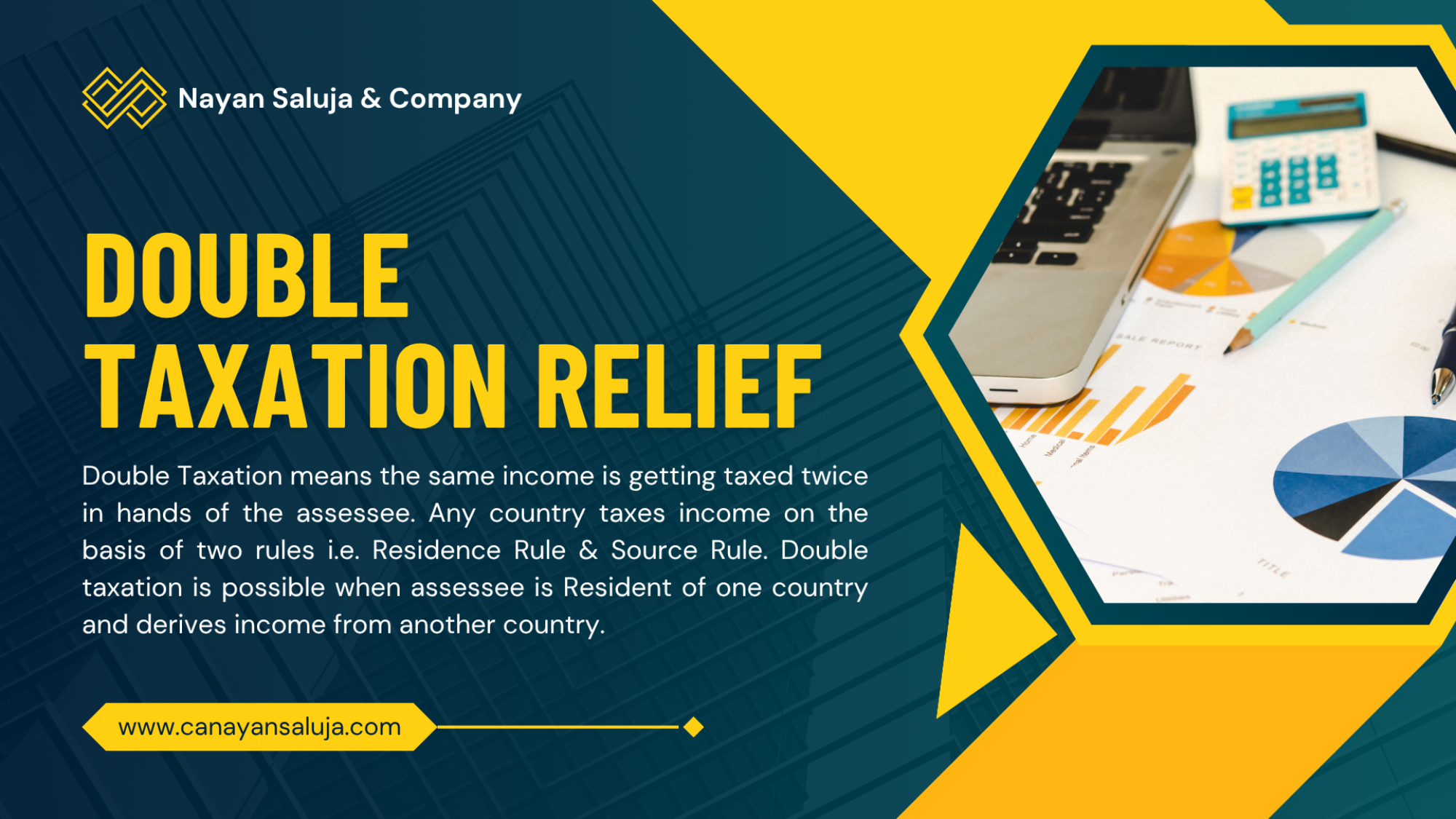DOUBLE TAXATION RELIEF (DTAA)
.
Double Taxation means the same income is getting taxed twice in hands of the assessee. Any country taxes income on the basis of two rules i.e. Residence Rule & Source Rule. Double taxation is possible when assessee is Resident of one country and derives income from another country.
.
Suppose Mr. Kamal is Resident of India and deriving income from U.S, then India will tax such income on the basis of Residence Rule and U.S will tax such income on the basis of Source Rule.
.
There are two types of Double taxation relief:
1.Unilateral Relief – No DTAA u/s 91.
2.Bilateral Relief – DTAA u/s 90 & 90A. (Tax exemption method & tax credit method).
Under Tax exemption method, income is taxed in only source country and exempted in the residency country. Under Tax credit method Income is taxable in both countries in accordance with their respective tax laws read with double taxation avoidance agreement. The country of residence of tax payer, allows him credit for the tax charged thereon in the country of source. India follows credit method in majority of its DTAAs.
.
SECTION 90: AGREEMENT WITH FOREIGN COUNTRIES (DTAA):
Central Government, may enter into agreements with Governments of foreign countries or specified territory outside India:
(a)For granting relief for Doubly Taxed Income, without creating opportunities for nontaxation or reduced taxation through tax evasion or avoidance (including through treaty- shopping arrangements aimed at obtaining reliefs provided in the said agreement for the indirect benefit to residents of any country or territory).
(b)Exchange of information with each other for prevention of tax evasion transaction, investigation of such cases & co-operation with each other for recovery of taxes.
Notes:
1.Provisions of DTAA or Income Tax Act whichever is more beneficial to the assessee shall apply (Section 90(2)). However, provisions of GAAR shall apply even if such provisions are not beneficial to the assessee.
2.The charge of tax in respect of a foreign company at a higher rate than the rate at which a domestic company is chargeable, shall not be regarded as less favourable charge or levy of tax in respect of such foreign company.
3.Non resident to whom DTAA applies, shall not be entitled to claim any relief under DTAA unless TRC (Tax Residence Certificate) of his being resident in any foreign country is obtained by him from Foreign Government (Section 90(4)).
.
TRC produced by a resident of a contracting state will be accepted as evidence that he is a resident of that contracting state and IT authorities in India will not go behind the TRC question his residential status.
.
In addition to TRC the assessee would be required to provide such other documents & information as may be prescribed for claiming the treaty benefit: –
• Pan of the assessee (if allotted)
• Nationality (in case of Individual)
• Country or specified territory for Incorporation or registration (In case of others)
• Assessee’s Tax identification number in the country of specified territory of residence & in case there in no such number the unique number on the basis of which the person is identified by the government or specified territory of which the assessee claims to be resident.
• Period for which the residential status, as mentioned in the certificate.
• Address of the assessee in the county or specified territory outside India.
However, the assessee may not be required to provide the information or any part thereof, if the information or any part thereof, as the case may be, is already contained in the TRC.
4.As per Section 90A “Specified Association” of India can enter into an agreement with “Specified Association” of foreign county. Central Government may adopt or implement such agreement. “Specified Association” means any association functioning under any law (E.g. RBI).
.
Section 91: DOUBLE TAXATION RELIEF IF THERE IS NO DTAA
(a)Assessee is Resident in India.
(b)Income derived from Foreign Country & income not deemed to be accrued or arise in India.
(c)Tax should have been deducted or paid in foreign country.
(d)There should be NO DTAA.
.
Amount of Relief:
Step 1: Compute Net Taxable Income (Indian plus foreign income).
.
Step 2: Find out Gross Tax (before claiming TDS/ TCS, MAT/ AMT credit, Advance tax but after adding surcharge & HEC).
.
Step 3: Find out “Average rate of tax” on NTI.
Average rate of tax = (Gross Tax * 100)/NTI.
.
Step 4: Find out rate at which tax paid/ deducted in foreign country
.
Step 5: Find out lower rate from step 3 & 4
.
Step 6: Relief u/s 91 = Foreign income * rate in step 5
.
TAXATION OF BUSINESS PROCESS OUTSOURCING (BPO) UNITS IN INDIA (CBDT CIRCULAR NO. 5/2004)
(a)A NR entity may outsource certain services to a resident Indian entity. If there is no business connection between the two, the resident may not be a PE of NR entity, and the resident entity would have to be assessed to income tax as a separate entity.
(b)However, it is possible that the NR entity may have business connection with the resident Indian entity. In such a case, the resident Indian entity could be treated as the PE of the NR entity.
(c)NR entity or the foreign company will be liable to tax in India only if the IT enable BPO unit in India constitutes its PE.
(d)NR or a foreign company is treated as having a PE in India if the said NR or foreign company carries on business in India through a branch, sales office etc. or through a agent who habitually exercises an authority to conclude contracts or regularly delivers goods or merchandise or habitually secures orders on behalf of the NR principal. In such a case, the profits of the NR or foreign company attributable to the business activities carried out in India by the PE becomes taxable in India.
(e)If BPO unit becomes PE in India, then profit attributed to such PE shall be taxable in India. Profit of PE shall be computed as if it were a distinct and separate entity. Transaction between PE and HO shall be computed on the basis of arm’s length price.
.
.



Add a Comment